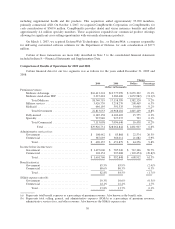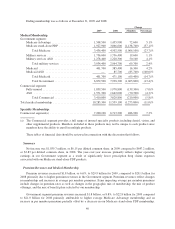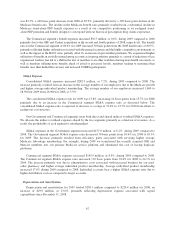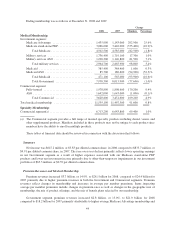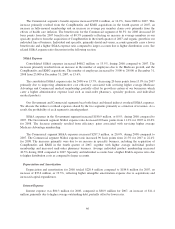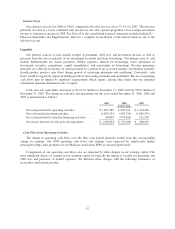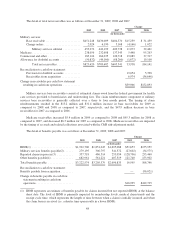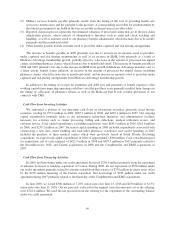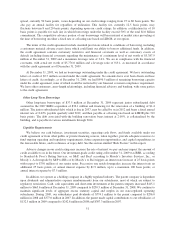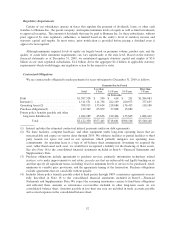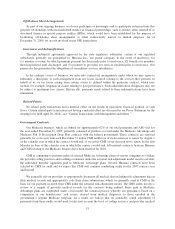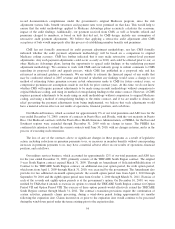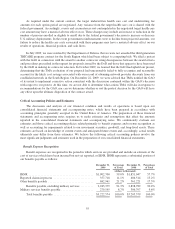Humana 2009 Annual Report Download - page 56
Download and view the complete annual report
Please find page 56 of the 2009 Humana annual report below. You can navigate through the pages in the report by either clicking on the pages listed below, or by using the keyword search tool below to find specific information within the annual report.The Commercial segment’s benefit expense increased $709.4 million, or 14.2%, from 2008 to 2007. This
increase primarily resulted from the CompBenefits and KMG acquisitions in the fourth quarter of 2007, an
increase in fully-insured membership and an increase in average per member claim costs primarily from the
effects of health care inflation. The benefit ratio for the Commercial segment of 80.3% for 2008 decreased 20
basis points from the 2007 benefit ratio of 80.5% primarily reflecting an increase in average members in our
specialty products from the acquisition of CompBenefits in the fourth quarter of 2007 and organic growth in our
individual line of business. Individual and specialty, primarily dental and vision, accounts generally carry a lower
benefit ratio and a higher SG&A expense ratio compared to larger accounts due to higher distribution costs. See
related SG&A expense ratio discussion in the following section.
SG&A Expense
Consolidated SG&A expenses increased $468.2 million, or 13.5%, during 2008 compared to 2007. The
increases primarily resulted from an increase in the number of employees due to the Medicare growth, and the
CompBenefits and KMG acquisitions. The number of employees increased by 3,900 to 28,900 at December 31,
2008 from 25,000 at December 31, 2007, or 15.6%.
The consolidated SG&A expense ratio for 2008 was 13.7%, decreasing 20 basis points from 13.9% for 2007
primarily due to improving administrative cost efficiency associated with servicing higher average Medicare
Advantage and Commercial medical membership, partially offset by growth in certain of our businesses which
carry a higher administrative expense load such as mail-order pharmacy, specialty products, and individual
medical products.
Our Government and Commercial segments bear both direct and shared indirect overhead SG&A expenses.
We allocate the indirect overhead expenses shared by the two segments primarily as a function of revenues. As a
result, the profitability of each segment is interdependent.
SG&A expenses in the Government segment increased $180.9 million, or 8.9%, during 2008 compared to
2007. The Government segment SG&A expense ratio decreased 60 basis points from 11.2% for 2007 to 10.6%
for 2008. The decrease primarily resulted from efficiency gains associated with servicing higher average
Medicare Advantage membership.
The Commercial segment SG&A expenses increased $287.3 million, or 20.0%, during 2008 compared to
2007. The Commercial segment SG&A expense ratio increased 90 basis points from 21.5% for 2007 to 22.4%
for 2008. The increases primarily were due to an increase in specialty business, including the acquisition of
CompBenefits and KMG in the fourth quarter of 2007, together with higher average individual product
membership and increased mail-order pharmacy business. Average individual product membership increased
40.5% during 2008 compared to 2007. Specialty and individual accounts bear a higher SG&A expense ratio due
to higher distribution costs as compared to larger accounts.
Depreciation and Amortization
Depreciation and amortization for 2008 totaled $220.4 million compared to $184.8 million for 2007, an
increase of $35.6 million, or 19.3%, reflecting higher intangible amortization expense due to acquisitions and
increased capital expenditures.
Interest Expense
Interest expense was $80.3 million for 2008, compared to $68.9 million for 2007, an increase of $11.4
million, primarily due to higher average outstanding debt, partially offset by lower rates.
46





